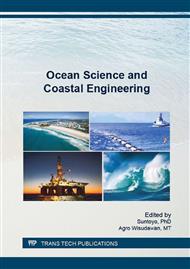p.67
p.72
p.78
p.83
p.90
p.96
p.102
p.107
p.115
Estimation of Sea Surface Temperature (SST) Using Split Window Methods for Monitoring Industrial Activity in Coastal Area
Abstract:
The three drivers of environmental change: climate change, population growth and economic growth, result in a range of pressures on our coastal environment. Coastal development for industry and farming are a major pressure on terrestrial and environmental quality. In their process most of industry using sea water as cooling water. When water used as a coolant is returned to the natural environment at a higher temperature, the change in temperature decreases oxygen supply and affects marine ecosystem. This research is presents results from ongoing study on application of Landsat 8 for monitoring the intensity and distribution area of sea surface temperature changed by the heated effluent discharge from the power plant on Paiton coast, Probolinggo, East Java province. Remote sensing technology using a thermal band in Operational Land Imager (OLI) sensor of Landsat 8 sattelite imagery (band 10 and band 11) are used to determine the intensity and distribution of temperature changes. Estimation of sea surface temperature (SST) using remote sensing technology is applied to provide ease of marine temperature monitoring with a large area coverage. The method used in this research using the Split Window Algorithm (SWA) methods which is an algorithm with ability to perform extraction of sea surface temperature (SST) with brigthness temperature (BT) value calculation on the band 10 and band 11 of Landsat 8. Formula which was used in this area is Ts = BT10 + (2.946*(BT10 - BT11)) - 0.038 (Ts is the surface temperature value (°C), BT10 is the brightness temperature value (°C) Band 10, BT11 is the brightness temperature value (°C) Band 11. The result of this algorithm shows the good performance with Root Mean Square Error (RMSE) amount 0.406.
Info:
Periodical:
Pages:
90-95
Citation:
Online since:
January 2017
Keywords:
Price:
Сopyright:
© 2017 Trans Tech Publications Ltd. All Rights Reserved
Share:
Citation:


